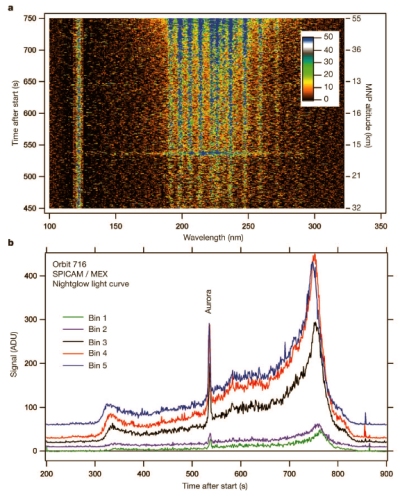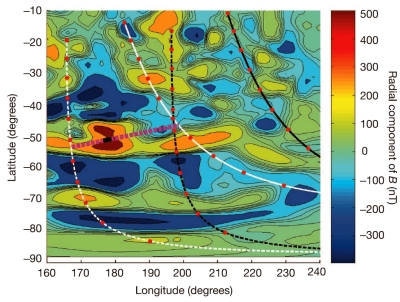Discovery of Martian Aurora
10 June 2005
Several planets within the Solar System are known to have high-latitude aurora: Earth, Jupiter, Saturn, Uranus and Neptune. In each case the cause is an interaction between electrically charged particles with the upper atmosphere along magnetic field lines. Mars, however, does not possess an internal magnetic field and so a different aurora mechanism must be considered. The Martian aurora is a highly concentrated, localised emission controlled by magnetic field anomalies in the Martian crust.In Nature (9 June 2005) Bertaux et al. report on observations, made using the SPICAM instrument on Mars Express scientist. Their findings suggest the discovery of a distinct type of aurora never before observed in the Solar System - a highly concentrated, localised emission controlled by magnetic field anomalies in the Martian crust.
 |
|
Figure 1: Detection of Martian Aurora |
The figure below shows variations in the intensity of nightglow over a 900 second period. The upper image shows intensity of emission wavelength over time with two main features: H Lyman-a emission at 121.6 nm and a band from 190-270 nm corresponding to the emission of an NO molecule from atmospheric recombination of oxygen and nitrogen. At the time of the auroral peak, around 535 seconds after the observations commenced, there is a clear change in the spectrum. The lower image shows the signal intensity for all five SPICAM channels, with a sharp peak also noticeable at around 535 seconds.
The second figure displays the variation of the position of the spacecraft during the observational orbit (Orbit 716) and the position of Mars nearest point (MNP) of the line of sight (LOS), superimposed on a map of the radial component of the magnetic field as determined by Mars Global Surveyor.
 |
|
Figure 2: Magnetic Field and Spacecraft Location |
The region of strongest crustal magnetic field is roughly at the location along the LOS determined for the auroral emission. At the time of the brightest signal the LOS was passing through the largest Martian magnetic crust anomalies.

